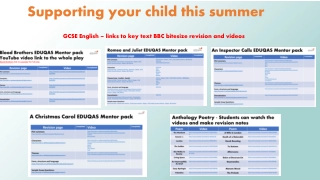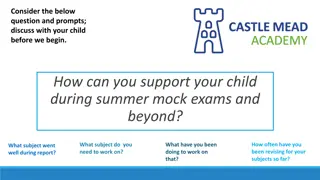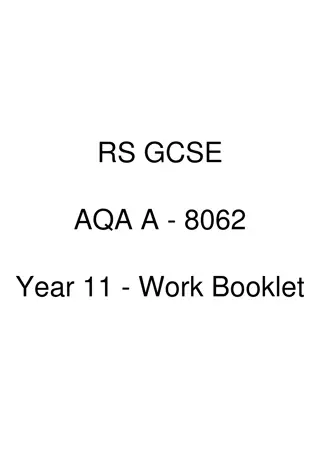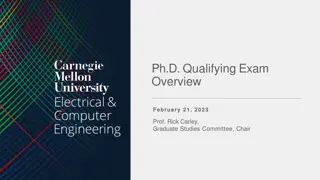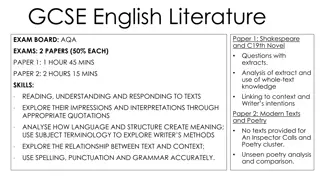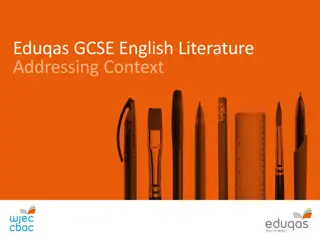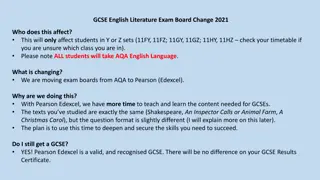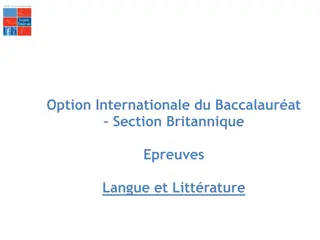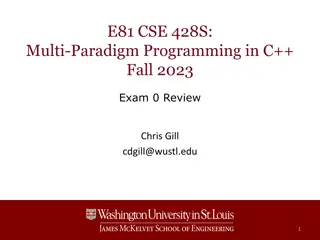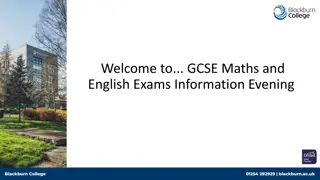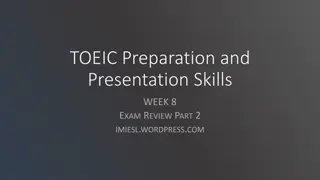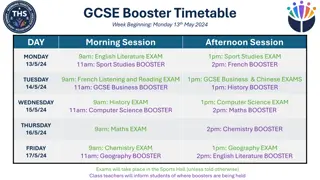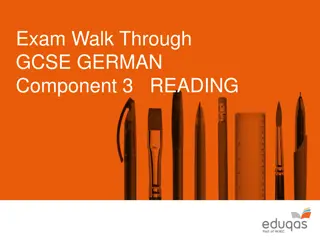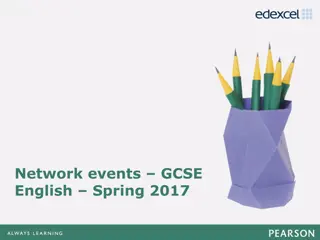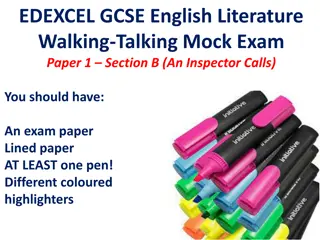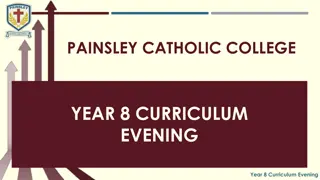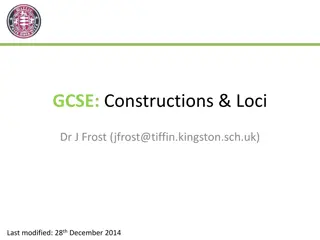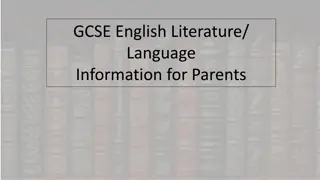GCSE Literature Exam Overview & Preparation
This text provides an overview of the GCSE Literature exam format, including details on papers, sections, and assessment criteria. It also covers key concepts such as poetic techniques, iambic pentameter, and exam question formats to help students prepare effectively. The focus is on understanding how to analyze and explore poetry, with a specific mention of the poem "Ozymandias" from the Power and Conflict anthology.
Download Presentation

Please find below an Image/Link to download the presentation.
The content on the website is provided AS IS for your information and personal use only. It may not be sold, licensed, or shared on other websites without obtaining consent from the author.If you encounter any issues during the download, it is possible that the publisher has removed the file from their server.
You are allowed to download the files provided on this website for personal or commercial use, subject to the condition that they are used lawfully. All files are the property of their respective owners.
The content on the website is provided AS IS for your information and personal use only. It may not be sold, licensed, or shared on other websites without obtaining consent from the author.
E N D
Presentation Transcript
Date: Title: Poetry from the Anthology: Power and Conflict Title: Poetry from the Anthology: Power and Conflict Starter: 5-a-Day 1. What is the name of the poetic technique in which a line is divided by a piece of punctuation? 2. Poems do not have paragraphs, they have ? 3. Iambic pentameter is a type of ..? 4. What is alliteration? 5. What is a visage? Aim: To understand, analyse and explore Ozymandias
Give yourself a mark out of 5 Give yourself a mark out of 5 Starter: 5-a-Day 1. What is the name of the poetic technique in which a line is divided by a piece of punctuation? CAESURA 2. Poems do not have paragraphs, they have ? STANZAS 3. Iambic pentameter is a type of ..? RHYTHM 4. What is alliteration? REPETITION OF CONSONANTS FOR DELIBERATE EFFECT 5. How many lines are there in a SONNET? 14 Aim: To understand, analyse and explore Ozymandias
The Anthology Write your NAME, FORM and ENGLISH TEACHER in the book. This is an examined part of the GCSE Literature course and you will need to keep this book safe! You may annotate it; you should also take notes in your exercise book.
EXAM: You will see the explanation of the Literature exams on the next slide.
Paper 1 40% 1hr 45 mins Paper 2 60% 2hr 15 mins Section A Macbeth Section A An Inspector Calls 20% of GCSE No choice of question Extract to whole AO1 AO2 AO3 AO4 (4 marks) 20% of GCSE Choose one of two possible questions Essay question AO1 AO2 AO3 AO4 (4 marks) 50-55 minutes (including 10 minutes reading/planning time) 45 minutes Section B Jekyll and Hyde Section B Poetry Anthology Section C - Unseen Poetry 1) Analysing unseen poem 2) Comparing two unseen poems 45 minutes 20% of GCSE No choice of question Extract to whole AO1 AO2 AO3 20% of GCSE No choice of question 20% of GCSE No choice of question Two parts 50-55 minutes (including 10 minutes reading/planning time) 45 minutes Aim: To understand how you will be assessed for GCSE English Literature
Question Format CLOSED BOOK 1: COMPARE 2: HOW: this is an analysis question, don t just tell the story. 3: ways that people are affected by war : this is the focus make sure you don t get distracted. 4: ONE other poem: you need to make a good choice. There is no need to try to use more than one.
POEM 1: OZYMANDIAS (Shelley) OZYMANDIAS (Shelley) We will read the poem and begin to consider the effects sought by the poet WHAT is he trying to say in this poem? HOW is he doing this and where do you find the evidence? WHY has he chosen to make his points in this specific manner?
What does this image tell us about power? Aim: To understand, analyse and explore Ozymandias
Percy Bysshe Shelley (1792 1822) Shelley was well known as a 'radical' during his lifetime and some people think Ozymandias reflects this side of his character. Although it is about the remains of a statue of Ozymandias (another name for the Egyptian pharaoh Rameses II) it can be read as a criticism of people or systems that become huge and believe themselves to be invincible. Shelley was a Romantic poet. Many Romantic poets wrote about the power of nature and time, exotic lands and criticised the ruling classes. Aim: To understand, analyse and explore Ozymandias
Ozymandias I met a traveller from an antique land Who said: Two vast and trunkless legs of stone Stand in the desert. Near them on the sand, Half sunk, a shatter'd visage lies, whose frown And wrinkled lip and sneer of cold command Tell that its sculptor well those passions read https://www.y outube.com/w atch?v=sPlSH6 n37ts Which yet survive, stamp'd on these lifeless things, The hand that mock'd them and the heart that fed; And on the pedestal these words appear: 'My name is Ozymandias, king of kings: Look on my works, ye Mighty, and despair!' Nothing beside remains. Round the decay Of that collossal wreck, boundless and bare, The lone and level sands stretch far away. Aim: To understand, analyse and explore Ozymandias
Sentence 1: meaning and vocabulary I met a traveller from an antique land Who said: Two vast and trunkless legs of stone Stand in the desert.
Section2 Near them on the sand, Half sunk, a shatter'd visage lies, whose frown And wrinkled lip and sneer of cold command Tell that its sculptor well those passions read Which yet survive, stamp'd on these lifeless things, The hand that mock'd them and the heart that fed;
Section 3 And on the pedestal these words appear: 'My name is Ozymandias, king of kings: Look on my works, ye Mighty, and despair!' Nothing beside remains. Round the decay Of that collossal wreck, boundless and bare, The lone and level sands stretch far away.
FORM: 14 Lines: A sonnet If sonnets are about love, in what way might this poem be seen as ironic? A single stanza with a VOLTA at Line 9 a turn in the poem. Technical Vocab: Lines 1 to 8: Octave Lines 9 to 14: Sestet.
Ozymandias I met a traveller from an antique land Who said: Two vast and trunkless legs of stone Stand in the desert. Near them on the sand, Half sunk, a shatter'd visage lies, whose frown And wrinkled lip and sneer of cold command Tell that its sculptor well those passions read Which yet survive, stamp'd on these lifeless things, The hand that mock'd them and the heart that fed; Iambic Pentameter: the basic rhythm of a sonnet. 5 x u/ (de dum) To be rewarded for engaging with form, look for the anomalies! (blue) And on the pedestal these words appear: 'My name is Ozymandias, king of kings: Look on my works, ye Mighty, and despair!' Nothing beside remains. Round the decay Of that collossal wreck, boundless and bare, The lone and level sands stretch far away.
Ozymandias: preparing to write. 5 a day challenge: 3: A sonnet is divided into 1 What sort of poet is Shelley? A: Octave and Sestet A: Modernist B: Octave and Sextet B: Romantic C: Octet and Sestet C: Georgian D: Sestet and Octave D: Epic 4: Give one reason for the capitalisation of the word Mighty which links to the theme of hubris or arrogance. 2 Repetition of a vowel sound is called A: Alliteration B: Assonance 5: Can you think of any modern parallels to this story someone of high status whose arrogance has led to a reversal of fortune before or after their death? C: Enjambment
Ozymandias: preparing to write. 5 a day challenge: 3: A sonnet is divided into 1 What sort of poet is Shelley? A: Octave and Sestet A: Modernist B: Octave and Sextet B: Romantic C: Octet and Sestet C: Georgian D: Sestet and Octave D: Epic 4: Give one reason for the capitalisation of the word Mighty which links to the theme of hubris or arrogance. The capitals might suggest that the words are addressed to the Gods. 2 Repetition of a vowel sound is called A: Alliteration B: Assonance 5: Can you think of any modern parallels to this story someone of high status whose arrogance has led to a reversal of fortune before or after their death? I want to hear your ideas there is no correct answer. C: Enjambment
How does Shelley present power in Ozymandias? How does Shelley present power in Ozymandias? What How Why Two vast and trunkless legs Building awareness of size and of destruction Emphasises size by stress on vast and reminder that these are trunkless Hubris comes before a fall and establishes the nature of the hubris Time to plan Look on my works, ye Mighty, and despair!' Using arrogant words ironically Rhythm change of stress for imperative and challenge to the Gods in Mighty Outward personality is cruel wrinkled lip and sneer of cold command To show arrogance and human power https://jwpblog.co m/2021/07/28/ozy mandias-an- introduction/ Establishes character with visual imagery and alliteration of contempt Nothing beside remains. CAESURA to stop the sense reflects the end of his power The sudden stop in the line reflects the end of Ozymandias reign. Emphasises the finality of the destruction Round the decay Of that colossal wreck, boundless and bare, The lone and level sands stretch far away. Reference to enduring power of nature 2x alliteration of L and B reinforce the loss of power We are left with the image of emptiness and of ruin Leaves us with clear message about Man s power being temporary Aim: To understand, analyse and explore Ozymandias
Planning: This exam requires a comparison for which 1 poem is printed to help you. We will answer this question: How do the poets present POWER in the poems Ozymandias and London? To plan, work with the one which is printed Ozymandias - before you try to make links with the second poem. You should try to compare throughout the essay.
Model and Structure Introduction: establish your knowledge and understanding of the two poems Around 4 paragraphs: Structure Establish an understanding of how the structure of the poem helps to convey the message Language: at least two paragraphs looking at specific language chosen by the poet to create effect.
Intro: need not have any quotations You might prepare an intro for each poem to help you to move quickly into the essay. For example: Shelley s sonnet Ozymandias explores how a ruler can show great Hubris in their lifetime, yet their power is short lived in the face of Nature. If you then have something like: Blake s deceptively simple ballad London explores the nature of societal corruption and its effect on the populace. The two can be linked effectively by the use of whereas and the change of the full stop to a comma: Shelley s sonnet Ozymandias explores how a ruler can show great Hubris in their lifetime, yet their power is short lived in the face of Nature, whereas, Blake s deceptively simple ballad London explores the nature of societal corruption and its effect on the populace.
Both poets use Structure (focus on Shelley) Sonnet: Ironic use of the love form. The VOLTA allows Shelley to change perspective and to introduce the voice of Ozymandias challenging the Gods. This is shown when he capitalises the word Mighty to suggest that the focus of the thought is no mere mortals. Rhythm: The Iambic Pentameter is changed for effect in L. 4 of the SESTET to emphasise the word Nothing . This idea is further strengthened by the Caesura which abruptly halts the line much as Ozymandias rule will have come to a sudden end. There are more ideas
Language: models Shelley uses visual imagery in Line 5 of the Octave by focusing on the nature of the features of the shatter dvisage . He suggests the lip to be wrinkled and uses alliteration of the letter C to emphasise the cruelty and contempt behind the sneer of cold command . Ozymandiasto be using IMPERATIVES (or command verbs) when he addresses the onlookers on the pedestal: Look on my works and Despair . The placing of the order to despair as the last word in the inscription gives it great strength and suggests the hubris in the pedestal s inscription. The closing 3 lines of the poem clearly reflect the fact that all human power is temporary. Shelley has chosen to use alliteration of B and L to emphasise the vastness of the empty land around this statue. In the last line, he emphasises the isolation with the word lone particularly to help the reader to see the sheer emptiness of the level sands.
Your turn Using the same structure, try to plan a few sentences which could be used in your essay. You may talk with a neighbour if you need to , but try to work on your own. We will then read London, before trying to write the essay at the end of the week.


